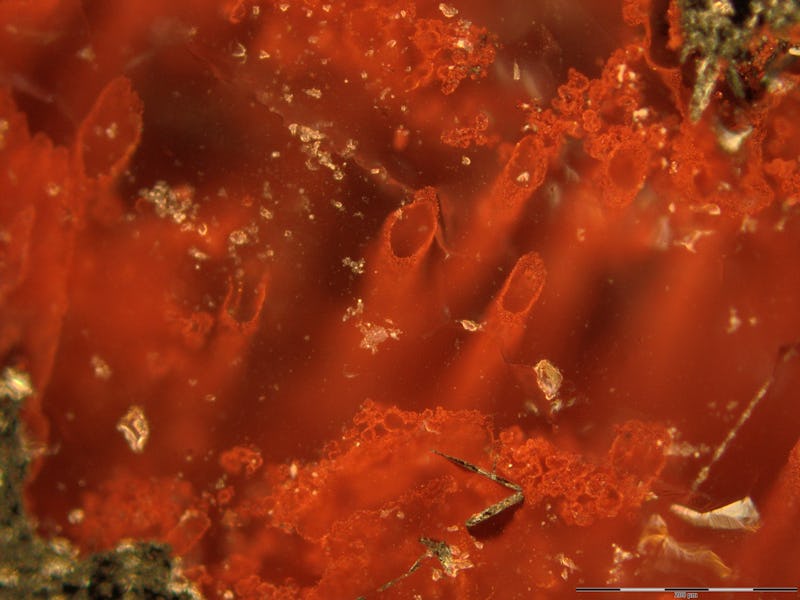Behold! 3.77 Billion-Year-Old Rusty Bacteria Poop
These rocks contain the oldest fossil evidence of life on Earth.

A team of researchers has announced the discovery of 3.77 billion-year-old rocks that contain the tiny fossilized remnants of fossilized bacteria. It’s the oldest physical evidence of life on this Earth — found in Canada’s Arctic. If confirmed, the find will open new avenues to the search for life on Mars and other planets. The research was published Wednesday in Nature.
“Our discovery implies that life originated within a few hundred million years of Earth history,” Dominic Papineau, a geochemist with University College London, tells Inverse. “It means that life can originate quickly if volcanoes interact with water and thus that life may have originated and evolved to a similar state of complexity on Mars because it had similar environmental conditions at that time.”
The fossils containing twisting, branching patterns of haematite — a type of rust — that the team believes were formed by bacteria that live near hydrothermal vents like those still seen at the bottom of the ocean today. “The twisted stalks (as we call them) in modern filamentous iron-oxidising bacteria in hydrothermal vent precipitates are the unwanted excreted product of the metabolism of these bacteria that eat ferrous iron and defecate ferric iron,” says Papineau.
Ancient bacteria formed these iron oxide inclusions in hydrothermal vent deposits in the Nuvvuagittuq Supracrustal Belt in Québec, Canada.
The study of ancient fossils is always controversial. Rocks that are three billion years old or older are hard to come by, as they have mostly been crunched up or eroded away many times over through Earth’s turbulent history. It’s harder still to look at ancient rocks and say incontrovertibly that the patterns within them are evidence of biological forces, and not some other non-organic process.
Last year a separate research team announced the discovery of stromatolites — a mound-shaped fossil remnant of complex microbial colonies that form a sort of mat in shallow seas — in Greenland that date to 3.7 billion years old. But more work needs to be done to say for sure that these patterns in the rocks were definitely formed by microbes, says Papineau. “The lack of carbon isotopes and graphite compositions prevents further interpretations, such that we can only speculate that they were formed by cyanobacteria.”
On the other hand, these rusty branching patterns in the rocks in this most recent find almost certainly could not have been formed by non-biological means, says Papineau. “We feel very confident that we discovered bona fide microfossils and the mineralized remains of their putrefied bodies. We have nine independent lines of evidence from our samples, and in addition, we also documented all these observations in younger microfossils in the same rock type, cited the literature on modern microorganisms that reports most of these biological signatures, and we had to reject the null hypothesis, which is that all the known non-biological explanations need to be rejected before a conclusive biological assignment can be reached.”
The ancient fossils were found in iron-rich rocks in the Nunavik region of Québec, Canada.
If these fossils are really ancient bacteria, it means that life arose and evolved quickly on Earth, and there’s no reason to believe it might not do the same on other planets under similar conditions. If all you need for life to take hold is a liquid ocean and some volcanic activity, Mars could very well have held life four billion years ago, too, and we may soon find similar-looking fossils on the red planet’s surface.
It could turn out that life is not something extraordinarily special, but instead something that, under the right conditions, is almost inevitable.
Abstract:
Although it is not known when or where life on Earth began, some of the earliest habitable environments may have been submarine-hydrothermal vents. Here we describe putative fossilized microorganisms that are at least 3,770 million and possibly 4,290 million years old in ferruginous sedimentary rocks, interpreted as seafloor-hydrothermal vent-related precipitates, from the Nuvvuagittuq belt in Canada. These structures occur as micrometre-scale haematite tubes and filaments with morphologies and mineral assemblages similar to those of filamentous microorganisms from modern hydrothermal vent precipitates and analogous microfossils in younger rocks. The Nuvvuagittuq rocks contain isotopically light carbon in carbonate and carbonaceous material, which occurs as graphitic inclusions in diagenetic carbonate rosettes, apatite blades intergrown among carbonate rosettes and magnetite–haematite granules, and is associated with carbonate in direct contact with the putative microfossils. Collectively, these observations are consistent with an oxidized biomass and provide evidence for biological activity in submarine-hydrothermal environments more than 3,770 million years ago.